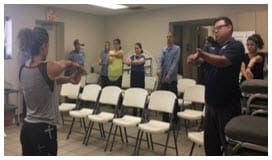Developing a Culturally Relevant Workplace Wellness Program: The Growers Company, Inc.

Available for Download pdf icon[PDF – 201 KB]

In 1950, Joe Rodriguez established The Growers Company, Inc. (GCI) based on the values of family, tradition, and inclusiveness. The company is owned by Joe’s sons, Mark and Sonny Rodriguez, and managed by Joe’s grandson, Trey Rodriguez. GCI employs more than 150 full time, year round employees and contracts with thousands of seasonal employees to harvest and package leafy green vegetables.
Locations: Headquartered in Somerton, AZ, with additional sites in Yuma, AZ, and Salinas, CA
Size: 159 full-time year-round employees; contracts with more than 6,000 seasonal full‑time produce harvesters
Industry: Farm labor contractor
North American Industry Classification System (NAICS) Sector: Agriculture, Forestry, Fishing and Hunting
Because 99 percent of GCI’s workforce is of Mexican descent, the workplace wellness program focuses on educating employees on health issues that are culturally relevant and important to recent immigrant and Hispanic populations. To meet the needs of its employees, GCI developed its own wellness program through partnerships with a local health system called Yuma Regional Medical Center (YRMC), the Maricopa County Department of Public Health (MCDPH), and a local worker’s compensation clinic.
History of GCI’s Wellness Program
Trey Rodriguez, General Manager and founder of the wellness program, discussed the workplace environment at GCI:
We hire exceptional people; we have a good company philosophy where people feel taken care of and feel part of a bigger team.
With the support of leadership, Trey Rodriguez founded GCI’s wellness program in 2013. He wanted to help GCI employees lead healthier lives, but at that time, the company’s insurance broker did not have a wellness program it could offer GCI. As a result, GCI partnered with YRMC and a local workers’ compensation clinic to develop its own wellness program, and MCDPH to assess the program’s progress annually.
Early on, the wellness program focused on raising awareness of health issues that disproportionally affect Mexican populations, such as heart disease and diabetes. Soon after, Trey saw a need to also focus on lifestyle change. GCI began encouraging and tracking participation in annual Health Risk Assessments (HRAs) and monthly education sessions, which are available in Spanish to all year-round employees.

In 2015, Trey participated in training through the Arizona Department of Health’s Healthy Arizona Worksite Program. This program provides employers with tools, technical assistance, and resources to create workplace health programs. In 2016, GCI hired Maricela Alvarado as its new full-time wellness program coordinator. She organizes and manages wellness events and activities, engages leaders and staff in the program, and monitors metrics, such as attendance at events, to assess progress.
Overview of GCI’s Wellness Program
GCI’s wellness program offers a variety of activities that are culturally and linguistically tailored to their employee population. GCI believes that a culturally competent program can empower employees to make lifestyle changes to improve their health. The wellness program includes:
- Annual Health Risk Assessment. Since 2014, GCI has offered all year-round employees a biometric screening and comprehensive lifestyle questionnaire. The assessment looks at employees’ health status and annual progress by comparing results to previous years (if available). Third-party health screeners privately review employees’ results one-on-one and discuss lifestyle changes that could improve their health. Sessions can be conducted in Spanish, if the employee prefers. GCI receives non-specific, aggregate participation data to track the overall percentage of employees who are screened each year.
- Monthly Educational Sessions. Sessions are available to all employees in Spanish. Session topics range from physical to mental/emotional to financial health.
- Weekly Healthy Food. To promote access to healthy food in the workplace, GCI provides fresh fruit for employees each week.
- Monthly Wellness Challenges. Challenges focus on walking, hydration, and weight loss, and are open to all employees, contractors, and family members. GCI also co-hosts Fun Walks at a local park three to four times per year. These walks are a friendly competition with other businesses to see which company has the most participants.
Developing GCI’s Wellness Program

Since 2013, GCI leadership and Alvarado have met with YRMC every six months to discuss lessons learned from recent events and to plan topics and events for the next six months. YRMC provides access to bilingual medical and clinical staff, who coordinate with Alvarado to plan and conduct education sessions at GCI. These providers are well versed in health issues that Mexican Americans face and offer cultural and language appropriate, evidence based resources for this population. GCI also has a longstanding partnership with a local worker’s compensation clinic that has extensive experience working with local farm labor contractors. GCI partners with the clinic to provide annual flu shots to all employees and contractors.
With the programs we’ve been given, they’ve motivated [staff] to go to the doctor more frequently, to do their physical check-ups every year. We’re given the health fair to [check] glucose levels, weight, cholesterol…to have a check-up every year; possibly many of [us] didn’t do that before.
Tailoring Wellness Programming to Employees’ Culture and Needs
Their experiences living on the U.S.-Mexico border help GCI’s leaders to be attentive to the culture and needs of employees. GCI knows that some aspects of Mexican culture, such as eating traditional pastries or cooking with lard, can contribute to poor health outcomes. GCI works with YRMC to offer education and materials on topics important to employees and their families, such as cardiovascular disease and diabetes. Also, CGI provides monthly wellness newsletters in Spanish and English for year-round employees.
In the classes, they’ve brought [in] different people to talk about different health matters, like diabetes, high blood pressure, overweight, stress, heart conditions…. We cover topics, according to what people are dealing with, and that is quite helpful to them. The classes are very good.
During the sessions, health educators point out that participants do not have to give up all of their favorite foods to be healthy. Instead of just saying, “Don’t eat that,” and trying to change traditional diets, GCI introduces employees to healthier alternatives to conventional foods. Suggestions include substituting corn tortillas for flour tortillas and using vegetable oil instead of lard. The wellness program also emphasizes portion control. Cooking demonstrations help employees see how healthier foods can also taste good. The wellness program also hosted a field trip to a large grocery store, where employees shopped for food and practiced reading nutrition labels. Employees found the trip to be an eye-opening experience.
The wellness program also considers the perspectives of its male and female employees. Although men comprise 65 percent of full-time, year-round GCI employees, the women who work in GCI offices are more involved in wellness activities.
GCI has taken steps to increase the involvement of male employees in its wellness program. This began with leaders, who are mostly men, modelling participation. They are always the first to get annual health screenings and then encourage employees to follow their example. Additionally, Trey and Alvarado work with mid-level supervisors to get their advice on and develop activities that can engage all employees. This helps to foster relationships with mid-level supervisors who then promote wellness activities to employees.
Sonny Rodriguez, GCI President and CEO, discussed how GCI’s wellness program trip to a grocery store became an educational opportunity for him and his employees:
The highlight for me was taking our workers on our bus to [the grocery store] and showing them how to read labels….Because a lot of people don’t know what’s in our foods.
Although all employees are not permanent U.S. residents—part of its workforce commutes from neighboring communities in Mexico—GCI believes it is important to provide for every employee’s health needs. GCI offers employees access to health benefits regardless of where they reside. Each year, Alvarado helps U.S.-based employees enroll in a health insurance plan through the health insurance marketplace. She also works with health insurance brokers to offer seasonal employees who live in Mexico a Mexico-based health plan. Many employees enroll in this plan because it allows them to secure affordable medical coverage and still see preferred providers in Mexico.
GCI’s Wellness Program Success
GCI measures the success of its wellness program through participants’ personal anecdotes and brief surveys used to collect feedback after educational sessions. GCI draws on both sources to improve the program and to select topics for upcoming events.
GCI’s success includes improved engagement with the program. In the first year, health-risk assessment participation was low (30 percent) as some employees simply did not want to know their scores because they did not want to get “bad” results. However, participation steadily increased, with rates jumping to 46 percent in 2016 and then to 74 percent in 2017. GCI credits this significant increase at all levels of the company to two main factors. The first is Alvarado, who is skilled at organizing and promoting wellness program activities. The second is strong support from mid-level supervisors and managers who champion wellness activities.
GCI leaders decided they needed to be role models before expecting their employees to accept this new program. Leaders were the first to sign up for the health screening and receive counseling on how to improve their health. Knowing that managers were making healthier choices, such as participating in the health challenges and choosing healthy food options during company events, increased employees’ awareness of the benefits of the wellness program.
Employees who have problems with [blood] sugar have decreased their consumption of sugar-sweetened beverages, and they have improved their glucose levels. Some employees who are overweight have lost some weight.
In 2016, GCI began using the CDC Worksite Health ScoreCard. Leaders use these data to identify focus areas for the wellness program and improvements for the work site. For example, in 2017, GCI set a goal to provide a lactation room to accommodate the nursing mothers who work in the office. During the remodeling of its facilities, GCI built the lactation room and achieved its goal.
Challenges and Future Plans
GCI confronted challenges in developing and rolling out the worksite wellness program. These included:
- Maintaining engagement in the wellness program. Leaders’ participation and modelling of healthy behaviors to improve their own health increased employee participation, and awareness of the program and its benefits.
- Maintaining engagement in the annual health-risk assessments and monthly education sessions. GCI uses multiple strategies to make participation easier and to create a culture where employee health is integral to the workplace.
- GCI pays for the time spent in educational sessions so that employees do not have to take personal time to participate.
- Wellness presenters from YRMC conduct educational sessions during the workday to make participation convenient for employees.
- When introducing a new topic, presenters also introduce a contest, raffle, or challenge to keep participants engaged. GCI leaders are committed to funding the program and continuing their partnership with YRMC to develop additional wellness activities. The program will continue to evolve as employees’ needs change over time. They hope the program will expand soon to include topics such as personal finance.
Advice for Other Employers
GCI’s leaders and wellness team encourage other employers to create a culture of health by making long-term commitments and providing a variety of supports. A company should invest money in behaviors they want to encourage. Examples of the investments GCI made include:
- Conducting wellness sessions during the workday to make participation convenient for employees.
- Paying employees’ hourly wage while they participate in wellness sessions.
- Providing access to healthy snacks by purchasing fruit for the office.
GCI also emphasizes the importance of knowing your employees and understanding their culture. This will help employers plan wellness activities that are culturally meaningful (for instance, increasing awareness of healthier alternatives to traditional foods.
Each week the company provides us fruit. In that way, instead of saying, “I’m going to eat a pastry,” you can say, “I’m going to eat fruit instead.” That motivates us. The fruit is there. It looks delicious. It’s like, “Hey there’s fruit, make the change. Do it for yourself. Don’t do it for anyone else.” I say the program does help us; it benefits us a lot in that respect.
Recommendations for Action
- Invest in worksite wellness programs by providing financial incentives for participation. Invest time in identifying resources and partners to support wellness activities.
- Assess your organization using tools such as the CDC Worksite Health ScoreCard.
- Use the initial results to identify strengths and set priorities for developing your program.
- Repeat the assessment process after changes are made to monitor and improve your program.
- Reach out to state government workplace health-related programs for resources. Your local health department can also become a partner to guide your efforts.